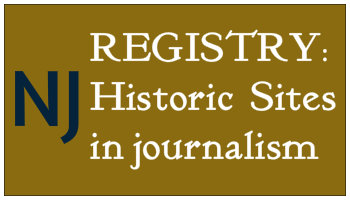 At NJ-SPJ, we value journalism history, so, in the spirit of our national organization’s program recognizing historic sites in journalism, we have decided to create a registry of historic sites in journalism dedicated to the Garden State.
At NJ-SPJ, we value journalism history, so, in the spirit of our national organization’s program recognizing historic sites in journalism, we have decided to create a registry of historic sites in journalism dedicated to the Garden State.
We’re kicking off our project by naming three sites to our registry: the Red Bank home of T. Thomas Fortune (1856-1928), who, in the late 19th and early 20th century, was one of the most prominent African-American journalists of his day, and The Union Hotel and Historic Hunterdon County Courthouse in Flemington, both important because of their connection to the 1935 Lindbergh kidnapping trial.
All three sites are in the New Jersey as well as National Register of Historic Places. The Historic Hunterdon Courthouse was restored in the late 1990s and is now used for special events such as re-enactments of the infamous trial, but both the Union Hotel and the T. Thomas Fortune home are in disrepair.
Of the three, only the Union Hotel — the quintessential grand Victorian hotel and which, together with the courthouse gives Main Street in Flemington its identity– is in danger of disappearing. That’s because the Flemington Borough Council has granted a redevelopment contract to a developer who wants to tear down four historic buildings, including the hotel, to build large, modern buildings and a parking garage.
The T. Thomas Fortune home was saved from the jaws of death in July when the city of Red Bank approved a plan by developer Roger Mumford to rehabilitate the home and convert it to a cultural center and build 31 luxury apartments in the style of the home in the back of the property. The project is expected to be completed by the spring of 2018, according to a report in the Asbury Park Press.
Fortune lived in Red Bank from 1901 until 1910. He called his home Maple Hall, and the house is located at 94 Drs. James Parker Blvd.
Fortune was co-owner and editor of The New York Age, the most widely read African-American newspaper of its day and known for its strong stance against lynching, discrimination, mob violence, and disenfranchisement of blacks in America. In 1892, when a white mob destroyed the Memphis newspaper owned by journalist Ida B. Wells, Wells found a new home on the pages of The New York Age as Fortune began publishing Wells’ investigative articles that documented how lynching was used as a means of social control.
Over the course of his career, Fortune wrote over 20 books and hundreds of editorials. Fortune’s involvement in two strong African-American advocacy organizations helped lay the foundation for the NAACP and other civil rights organizations that followed.
The Union Hotel and Historic Hunterdon County Courthouse are important sites in journalism because of their connection to the Lindbergh kidnapping trial, which, in 1935, turned the sleepy town of Flemington, New Jersey into the epicenter of a media circus. The courthouse, of course, is the site where the trial itself unfolded, but it was across the street, at the Union Hotel, where the lawyers and reporters stayed and drank. The crowd included legendary journalists such as Dorothy Parker, Walter Winchell, H. L. Mencken, and Arthur Brisbane. Damon Runyon was also there, but he was a teetotaler by then.
With its red-brick façade, mansard roof and two-story porch, the Union Hotel was originally built as a stage-coach stop in 1814, though in 1878, the exterior was changed to what we now see. The hotel is across the street from the courthouse. The courthouse was built in 1928 in the Greek Revival style and one of the oldest surviving country courthouses in the state. It was in use until 1996 when the new County Justice Center opened.

Be the first to comment on "NJ-SPJ starts Garden State Registry of Historic Sites in Journalism"